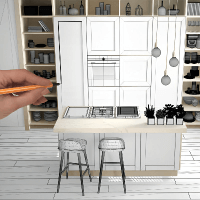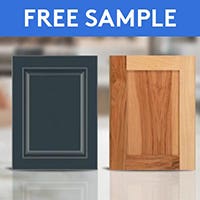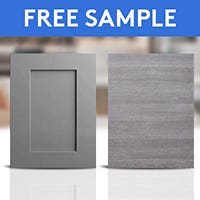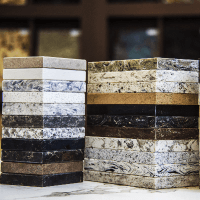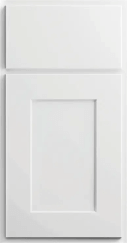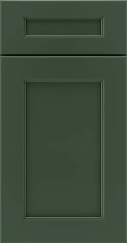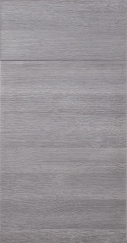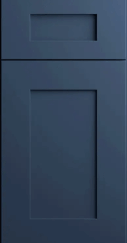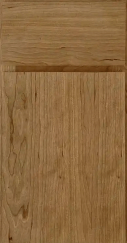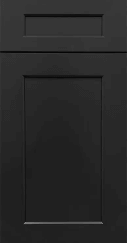National Certifications Affirm Quality of CliqStudios Cabinetry

At CliqStudios, we are committed to manufacturing cabinets of the highest quality, that will provide years of service in a healthy environment. National recognitions summarized below testify to our success in those efforts.
American National Standards Institute (ANSI) Testing
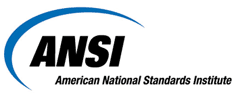
ANSI designs tests specifically for cabinet certification. Tests are performed by approved third-party independent laboratories. Samples for testing are selected in an unannounced visit to the manufacturing plant.
Five Tests Measure Kitchen Cabinet Structural Integrity
- All shelves and bottoms are loaded at 15 pounds per square foot, and loading is maintained for seven days to ensure that there is no excessive deflection and no visible sign of joint separation or failure of any part of the cabinets or the mounting system.
- Mounted wall cabinets are gradually loaded to 600 pounds without any visible sign of failure in the cabinet or the mounting system.
- 250 pounds is applied against the inside of cabinet-front stiles for cabinets with drawer rails to ensure reliable front joints that will not open during stress in service or during installation.
- A three-pound steel ball is dropped from six inches above the surface of shelves, bottoms and drawer bottoms to ensure they can withstand the dropping of cans and other items. After the tests, the drawer must not be damaged and must operate as before the test with no visible sign of joint separation or failure of any part of the cabinet or mounting system.
- A 10-pound sandbag is used to strike the center of a closed cabinet door. The test is repeated with the door opened to a 45-degree angle to test the ability of cabinet doors and connections to withstand impacts. The door must operate as before the test and show no damage or sign of separation or failure in the system.
Two Cabinet Drawer Tests
- Drawers are loaded at 15 pounds per square foot and operated through 25,000 cycles. The drawers must then remain operable with no failure in any part of the drawer assembly or operating system, and drawer bottoms must not be deflected to interfere with drawer operation.
- A three-pound weight is dropped 8 inches against the drawer assembly (box). After 10 drops, there must be no evidence of looseness or structural damage to the drawer-front assembly that impairs operation.
Two Door Operation Tests Measure Durability
- 65 pounds of weight is applied on the door. The weighted door is slowly operated for 10 cycles from 90 degrees open to 20 degrees open and returned to the 90-degree position. The door must remain weighted for 10 minutes, after which the door and hinges must show no visible signs of damage, and connections between cabinet and hinge and door and hinge must show no signs of looseness.
- Doors are opened and closed through a full 90-degree swing for 25,000 cycles. At the test’s conclusion, the door must be operable, the door-holding device must hold the door in closed position, hinges must show no visible signs of damage, connections between cabinet and hinge and door and hinge must show no sign of looseness, and other specifications must be met.
Four Cabinet Finish Tests
These tests create, in accelerated form, the cumulative effects of years of normal kitchen conditions of pre-finished cabinets. Cabinet finishes are inspected to ensure that stringent standards of appearance are also met.
- A cabinet door is placed in a hotbox at 120° F and 70% relative humidity for 24 hours. After this test the finish must show no appreciable discoloration and no evidence of blistering, checks, or other film failures.
- A cabinet door is placed in a hotbox at 120° F and 70% relative humidity for one hour, removed and allowed to return to room temperature and humidity conditions, and then placed in a cold box for one hour at -5° F. The cycle is repeated five times. The finish must then show no appreciable discoloration and no evidence of blistering, cold checking or other film failure.
- Exterior exposed surfaces of doors, front frames, drawer fronts and end panels are subjected to vinegar, lemon, orange and grape juices, tomato catsup, coffee, olive oil, and 100-proof alcohol for 24 hours and to mustard for one hour. After this test, the finish must show no appreciable discoloration, stain, or whitening that will not disperse with ordinary polishing and no indication of blistering, checks, or other film failure.
- A cabinet door edge is subjected to exposure to a standardized detergent formula for 24 hours. The door edge must then show no delamination or swelling and no appreciable discoloration or evidence of blistering, checking, whitening, or other film failure.
CliqStudios cabinets have passed the above ANSI (American National Standards Institute) A161.1 performance and construction tests for kitchen and vanity cabinets. The tests listed above are performed by approved third-party independent laboratories. The program is referenced by U.S. government agencies, architects, builders, remodelers and other specifiers. Cabinets that comply and bear the certification seal are recognized in the marketplace as a quality product able to perform after a rigorous battery of tests simulating years of typical household use.
Carb 2 Compliant – Protecting Indoor Air Quality

In April 2007, the California Air Resources Board (CARB), a department of the California Environmental Protection Agency, voted to implement new limits for formaldehyde emitted from composite wood panels. The first phase, known as CARB Phase 1, was implemented in January 1, 2009. The final phase will be in place by 2012, the regulation will establish the toughest production standard in the world for formaldehyde emissions from composite wood panels. California’s environmental protection regulations are among the most stringent and rapidly evolving in the nation.

The California regulation governs the formaldehyde in both raw composite wood panels and finished products sold or used in California. Both imported and domestic products are regulated, and must be third-party certified and clearly labeled to indicate they meet California’s requirements. The new requirements set upper limits on formaldehyde emissions from composite wood products sold in California or used to make finished goods offered for sale in California. The first phase of the regulation, known as CARB Phase 1, took effect on January 1, 2009. All CliqStudios Cabinetry products are 100% compliant with CARB Phase 1 and CARB Phase 2 defined guidelines of composite wood products.
